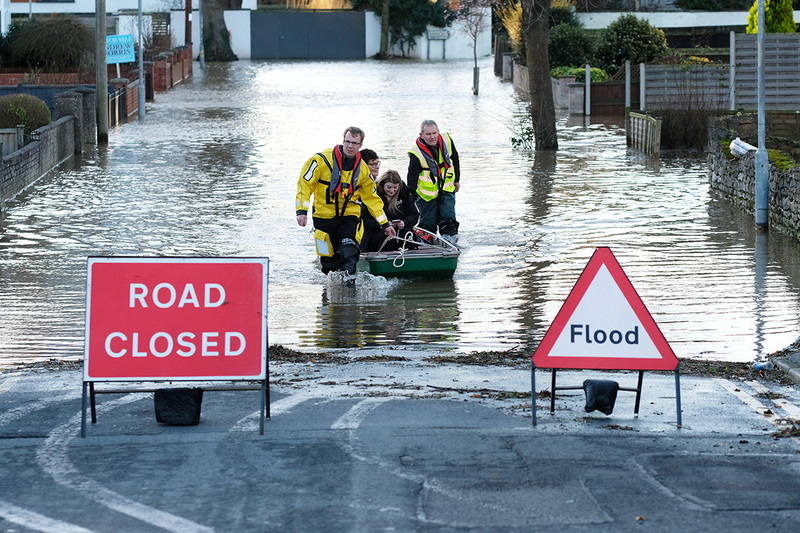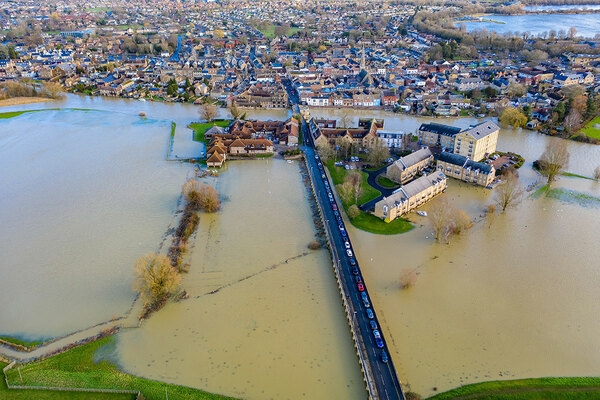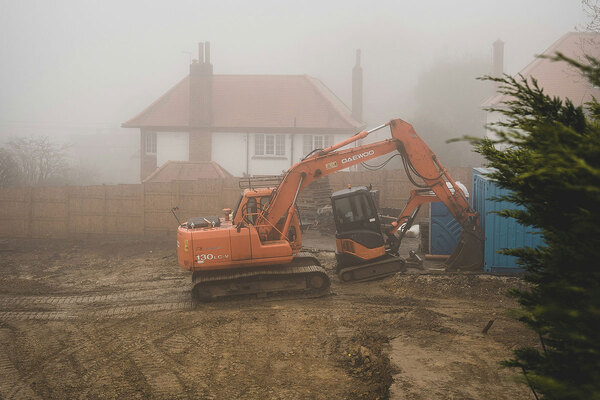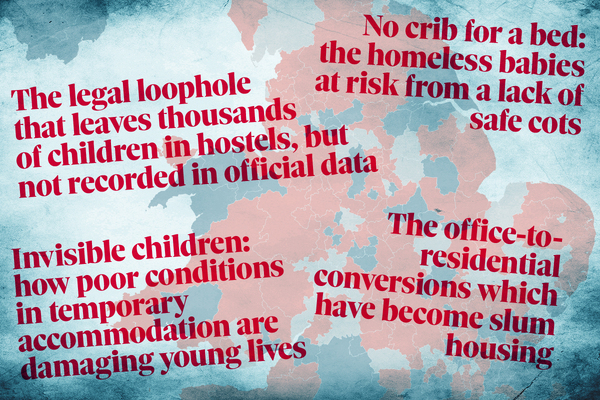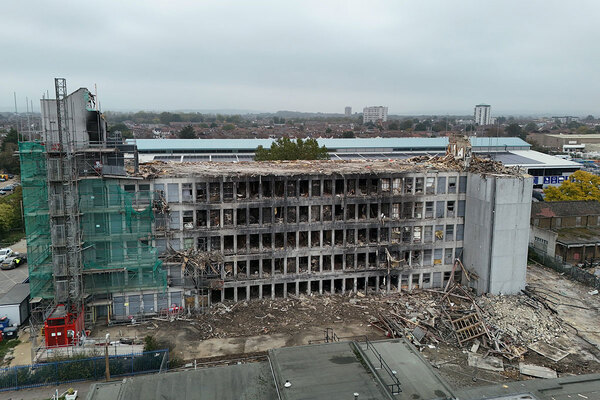You are viewing 1 of your 1 free articles
The water will come: how should the social housing sector prepare for a wetter world?
Peter Apps looks at how social landlords should prepare themselves to respond to flood emergencies, which are set to become more frequent as the climate changes
The Water Will Come is the title of a book on climate change by author Jeff Goodell, but it is also a reasonably succinct description of how social landlords should be adapting their housing management plans over the next few years.
“Flooding is just going to happen more frequently, we know that and we have to prepare for it,” says disaster expert Professor Lucy Easthope. “What I am saying to housing associations I speak to now is you are setting a climate change policy. Whenever you write a strategy, you need to be considering flooding. It doesn’t matter if you can’t see a river and it hasn’t happened before.”
So what should the sector be doing to ensure it is ready? Inside Housing has spoken to some of those leading on this to find out.
As with most risks, the real work is done before the problem crystallises. Right from the stage of new build, social landlords should be thinking about flooding.
Paula Heatley is new homes delivery director at Platform, a 48,000-home housing association which operates across some very low-lying areas in the Midlands. She says stress-testing the flood risk of all new development opportunities is a critical step the organisation takes in deciding whether or not to go ahead with a new project.
“It’s like financial stress-testing – you look at all the worst possible outcomes to understand the impact,” she says. “You need to be asking: does this allow for future climate change, but also whether it has additional capacity beyond that, and if it doesn’t, what is the plan and what does the modelling show for flood risk?”
A big problem can be that while flood modelling can demonstrate what the risk of a new development is, it doesn’t always take into account what will happen to the surrounding land.

Engineering solutions
“A lot of the time, you’re looking at what you’re buying, and you’re relying on external data to understand the wider infrastructure and the uses of neighbouring land, all of which can impact flooding. I think historically, that’s been a mistake that many landlords have made,” she says. Simply put, if the land next door changes from grass to concrete, that will change the flood dynamics. Water will now pour into the housing association’s development, where the initial strategy had said it would not.
It is possible to engineer in solutions: additional drainage, flood defences, raised ground floors, or even protections in the event that water does get into people’s homes, like ceramic flooring and higher plug sockets.
New regulations coming into force this year require ‘sustainable drainage systems’ or SuDS – rain gardens, ponds, and brick paving instead of slabs.
“We want to make sure we know what we’re going to do if flooding does occur, because we think at some point this will happen”
But this comes at a cost – not just to the specification of the design, but to the ongoing management, which may be reflected in service charges.
These are the sort of things development and acquisition teams need to be considering, but what about the flood risk to existing homes?
The first step is preparation. A year ago, Sunderland-based 30,000-home housing association Gentoo commissioned consultancy SHIFT to assess its vulnerability to fluvial and surface water flooding (see box, Types of flooding).
All of its properties have been categorised by risk and it has acted accordingly.
Types of flooding
- Fluvial – when a river, stream or brook overflows its banks
- Tidal – the inundation of coastal areas during extreme high tides or storm surges
- Surface water – when rainfall exceeds the capacity of drains, sewers and natural drainage
- Sewer flooding – when water from the sewer system leaks up through toilets, baths or sinks directly inside properties
Gentoo has agreed minimum stock levels of sandbags, dehumidifiers and other key items with local merchants, to prevent a scramble for kit when a flooding event occurs.
The landlord has 3,235 properties in ‘high-risk’ areas – all from surface water rather than fluvial flooding. Whenever it rewires one of these homes, it moves the plug sockets higher up the walls.
While none of these properties have flooded recently, Gentoo is conscious that this is no cause for complacency.
“We recognise things are only going to get wetter, so we want to make sure we know what we're going to do if it does occur, because we think at some point this will happen,” says Peter Akers, associate director – assets at Gentoo.
Dawn Clark, housing services director at Castles & Coasts Housing Association, a landlord with 7,200 homes across the North of England, says its approach is based on early intervention.
“There have been instances in the past where homes have been flooded in the Cumbria area. One of our priorities after our merger in 2017 was to pull together a robust flood response plan, based on early identification and intervention,” she says.
The organisation visited every resident that lives in a property in areas at potential risk of flooding and ensured each has a personal plan – updated as circumstances change – about what would happen if a flood occurred.
“Our plans are all based around getting residents to safe, alternative accommodation and securing the property before any flooding could occur,” she says.
Flood response
The landlord has a flood response team out of hours every day between October and March monitoring the risk.
The team watches the river levels via Environment Agency cameras, as well as flood warnings and updates from the local resilience forums. “If any of the triggers are met, the situation is escalated, and we can decide if we need to implement our flood response plan,” says Ms Clark.
If this means residents are evacuated as a precaution, the organisation's in-house contractor, Castles & Coasts Services, comes in to put up flood gates and window covers. The properties in at-risk areas are already fitted with various resilience measures, such as non-return valves on toilets (which stop water flooding up from overflowing sewage pipes), as well as flood doors and windows.
“We’ve had to provide information about our flood risk plans and whether we have contingency plans in place. That’s a question that previously hasn’t been asked in any real detail”
“We believe that the cost to us to do this is nothing compared to seeing how disruptive and stressful it can be for residents if they are flooded. It can be extremely catastrophic, especially for older residents,” she says.
But the trouble with early intervention is that it relies on flooding being predictable. It is possible to tell when rivers will overflow, and to get an idea from historic data about the likelihood of surface water floods. But in big cities particularly, where the landscape is regularly changing and rainfall is becoming increasingly erratic and unpredictable, predicting a flooding event is hard to impossible.
London, for example, saw serious surface water flooding events in July 2021 where one road was impacted and the next road along was not.
“Even when we know there is heavy rainfall coming, we don’t know the area where it is going to trigger flooding,” says Katharina Winbeck, strategic lead, transport and environment at the London Councils umbrella group. “There were locations a couple of hundred metres apart where one flooded and the other didn’t.”
She advises housing associations in the city to have as clear an idea as possible of the risk maps and which of their properties might be impacted.
“There are things you can and should do if you know a property is at risk of flooding,” she says. “Residents need to know, for example, to locate valuables upstairs and have a pack ready with things they might need such as medication, nappies and baby formula if they are going to have to escape. Then there are changes which can be made to the property like higher plug sockets and no-return valves on toilets.”
She adds that social landlords will need to be mindful of the aftermath of flooding. “Being flooded is a life-changing event,” she says. “You never quite trust where you live again and you’re always scared when you hear the rainfall. Social landlords need to be aware of that.”
Indeed, supporting traumatised residents through the rehousing process during and after a disaster will be one of the most critical roles the sector plays in these sorts of events. It is not easy, and has gone wrong in the past.
Professor Easthope says the actions taken by a social landlord in the aftermath are crucial in how a recovery progresses.
“The first stage in any housing emergency is an impact assessment and realistic assessment of how long the resident will be out for. You have to be honest with residents from the start if you want to maintain trust. We see really poor briefings about how long this is going to take sometimes,” she says.
If any of Gentoo's properties do flood, the association will send a trained building surveyor to inspect the property.
Its repair work is not only targeted at making the property clean and dry, but more flood resilient in future: this may include relocating energy metres and boilers above the flood level, rewiring electrical points, replacing floors with resilient materials such as ceramic tiles and improving the waterproof membrane on external walls.
But this would take time, and the landlord has invested in a specific safety and support team which any flooded residents will be referred to, where they can receive counselling and financial support while they are away from their home.
Basic flood recovery procedures
Guidance from the British Damage Management Association on the aftermath of flooding is available here. Advice includes:
Don’t expect things to return to normal in the immediate future. Recovering buildings and property damaged by flood water can be a lengthy and specialised process
Don’t be taken in by unscrupulous contractors. Because you want to get back to normal as quickly as possible, it is easy to agree to a seemingly cheap and immediate solution. Using inexperienced or unprofessional contractors could lead to major problems and prove very expensive
Control, measurement and records of drying progress are essential. Buildings and/or contents should be left in the same condition as before the incident where at all possible
After flood or water damage, the competent restorer will aim to leave buildings and contents clean, dry, odour free and sanitised
Tidying up must also be done carefully. Cleaning and drying a flooded property is very specialist work, which requires specialist contractors. They must also be trained to show respect to people’s homes and possessions, to gain consent before throwing anything away, and to take great care about damaging the property during the clean-up.
“One of the hardest things about initial recovery can be the damage that is done by the tidying up and drying up,” says Professor Easthope.
Contents insurance
Another major issue is contents insurance – while the landlord’s insurance should cover damage to the building, many renters do not have separate insurance for their possessions, so can find themselves rendered destitute by flooding.
“Housing associations must chat to their insurer about what’s covered and what’s not,” says Professor Easthope. “You need to be clear about what insurance covers, but as a board, what else are you covering? You need to answer these questions before the incident happens.”
The insurance industry is becoming increasingly interested in flood planning – something which may drive providers to give it a higher priority. “As part of the renewal of premiums, we’ve had to provide information about our flood-risk plans and whether we have contingency plans in place. That’s a question that previously hasn’t been asked in any real detail,” says Gentoo's Mr Akers.
“An East Coast flood scenario is terrifying. The areas at risk have a lot of older social housing, and a lot of older people”
These plans turn on data, which must be in place before the flood. “You have got housing associations losing time in the first few hours where they are working out whose block it is, which I would really like to see improved,” says Professor Easthope.
Another big problem – one which really needs to be fixed at a higher level – is our ongoing reliance on hotels for rehousing. After Grenfell and many other fires and building safety-related evacuations, residents have been moved to hotels. While this may be all that is available for a short-term crisis, the process of drying out and repairing a flooded home is long.
Regular hotel moves and a lack of basic family facilities simply do not make for good long-term options, but there remains a reluctance in this country to follow the examples of New Zealand or the United States and look at temporary villages and lodges instead. This was done in the UK in 2007, with 52 residents moved into a purpose-built caravan park in Doncaster following summer floods. The park – with fully functioning utilities – was set up in seven weeks.
“An East Coast flood scenario is terrifying,” says Professor Easthope – a reference to the impact of a storm surge and high tide pushing water down from the North Sea along the East Coast of Britain and into the Thames, as happened in 1953. “The areas at risk have a lot of older social housing, and a lot of older people. We really need to answer the question about how we rehouse people if something on that scale happens.”
As we pick our way through the challenges of a hotter, wetter century, these are questions we need to answer as a society. But housing organisations can start the process with their own well made, well prepared plans.
Recent longform articles by Peter Apps
Cladding remediation: why is progress so slow?
It has been nearly seven years since the Grenfell fire, yet thousands of buildings are still in need of cladding remediation. Peter Apps investigates why the process has been moving at such a glacial pace
How a ‘Google Maps of heat loss’ might make retrofit easier to plan
Technology is opening up new ways to quickly assess which homes are leaking heat, making them a priority to retrofit. Peter Apps reports
What it is like to live in Nine Elms as an affordable housing resident
While the wealthy private owners of flats in Nine Elms enjoy the use of the swimming pool and orangery, affordable housing tenants are struggling to get repairs done. Peter Apps reports
The water will come: how should the social housing sector prepare for a wetter world?
Peter Apps looks at how social landlords should prepare themselves to respond to flood emergencies, which are set to become more frequent as the climate changes
The office-to-residential conversions which have become slum housing
Poorly converted office blocks are putting people in temporary accommodation at risk of serious harm. Peter Apps reports
Sign up for the IH long read bulletin
Already have an account? Click here to manage your newsletters
